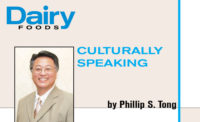With the start of a new year just around the corner, it would be useful to know what opportunities are looming on the horizon and beyond for cultured products category growth. Consumer decisions in food choices are complicated and multifaceted. But I have identified three category drivers you should consider.
First: consumer interest in getting more nutrition from whole foods. Many consumers are convinced that eating more nutritious foods will improve their wellness. They will implement this eating strategy by choosing more whole (natural) foods.
This bodes well for the cultured milk products category which traditionally has had a healthy halo which can be backed with facts about providing nutrient dense (protein, vitamins, minerals) foods in tasty, economical, and convenient forms.
Let potential customers know your product is a wholesome food! You might think the basic benefits of cultured milk products are well known and are old news, but I do not agree.
It is important to keep educating existing and new consumers about our category’s great nutrition story and do so in fresh and attention-catching ways. At a recent international dairy meeting it was estimated that globally 1 billion people work on behalf of the dairy industry (600 million in dairy farms and 400 million in related sectors). Positive dairy messages could go viral if we retweeted such positive messages about the health benefits of regularly consuming cultured milk products. Consumers want to know that there are people within the dairy industry who are passionate about the products they produce.
Keep it simple
Some consumers want to avoid processed foods and empty calories from added sugars. With new nutritional labels requiring declaration of added sugars, sugar content will take center stage. Using tools that can insure the best-tasting product without excessive amounts of added sugar will win the day. Hydrolyzing the naturally occurring milk sugar (lactose) can also help to enhance and reduce sucrose and other sweetener additions (see my column in the February issue).
Short and easily understood ingredient statements will go a long way to reinforcing dairy’s inherent natural goodness, because some consumers seek to avoid ingredients that do not sound like they come from their own kitchen. Anything that sounds like a chemical or artificial ingredient will not “fuel” these consumers to buy your product.
Use health and wellness ingredients
Second: Other consumers seek an “extra kick” of health and wellness. I’m talking about functional food components for cognition, satiety, immunity, intestinal health, body composition, etc. These consumers are willing to go to great lengths to get food components into their diet they believe will get them towards their “optimal” health and wellness status. This trend is tailor-made for cultured dairy to reap the benefits.
Yogurt and other cultured dairy foods are inarguably viewed as convenient, easy-to-consume and readily available foods that would be received well as delivery systems for additional “health and wellness” components that can fall short in the typical Western diets. Highlighting these components in your products could encourage a daily regimen of consumption. I’m talking about functional food components like soluble fiber (which reduce the risk of coronary heart disease), carotenoids (antioxidants), vitamin D (bone health, anti-inflammation), lutein (healthy vision), omega-3 fatty acids (reduced risk factors for CHD), phytosterols (anti-tumor), lycopene (promote prostate health) and other ingredients.
Cultured dairy products in all its iterations – spoonable, drinkable, conventional, high-protein, unflavored, flavored, standard cultures, probiotic bacteria with prebiotics – continue to capture a growing share of consumers (from toddlers to teenagers, young adults to seniors) who desire convenient, good-tasting health and wellness foods. By the way, a little more fat can go a long way to insure a pleasant eating experience without added gums and stabilizers.
The third driver is sustainability
Third: substantiated sustainability achievements can drive consumer choices. Millennials brought sustainability of people, planet, process and place into our daily lives. Retailers seeking to capture this consumer segment have responded and the rest of us (or at least many of the rest) are now embracing the ideas of sustainability.
This is a global movement. Dairy farmers and dairy processors are doing their part to be good stewards of our global resources. Communicating these efforts (on websites and on-pack) resonates with consumers and positively influences choices.
Finding successful ways to fuel growth in a category that has been around for a long time is not an easy task. But a one-size-fits-all approach to delivering on a wide range of consumer needs will not work. Developing customized market and product line strategies that recognize a variety of diverse consumer segments can provide some energy for new growth in the cultured dairy products category.



